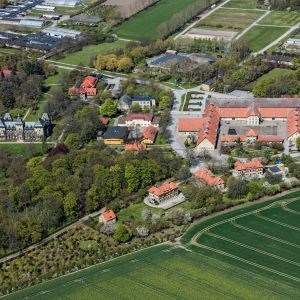The campus development process

Campus Alnarp is a unique place with a rich history. The ongoing development process includes both renovations and new construction to meet the needs of its operations in the short and long term. In December 2027, we will have a train stop in Alnarp, and the two faculties at Campus Alnarp will utilise new land for research facilities. We see the potential for Alnarp to contribute to and serve as a model for more sustainable societal development in southern Sweden, as well as nationally and globally. The level of ambition should be high.
Background
In 2012, the Campus Plan Vision Alnarp was created through collaboration between SLU and Akademiska Hus. Roughly five years later, the parties decided to jointly revise the document and collectively investigate how the physical environment at Campus Alnarp can be developed to best support SLU's operations in the future. In 2019, the vice-chancellor decided on a new Campus Plan Alnarp (only in swedish).
Well-functioning facilities are as important as an inspiring outdoor environment for research and education. Several investigations from various perspectives have been conducted by reputable landscape architects.
The investigations have provided us with a foundation for the ongoing development of the Alnarp campus. The French landscape architect Michel Desvignes was commissioned in 2019 to analyse the landscape around Alnarp. He presented his thoughts on what appeared to be a simple yet transformative spatial concept for the Alnarp campus, a vision that emphasised the campus as a green oasis with its surrounding agricultural landscape and proximity to the sea. In 2022, Mareld Landscape Architects AB was tasked with conducting an in-depth landscape analysis of the outdoor environment at the Alnarp campus. The purpose of the assignment was to produce in-depth analyses of the campus landscape in Alnarp, with a particular focus on the location of new facilities and the development of vegetation on campus.
In addition to this, decisions have been made regarding train connections to Alnarp.
Vision and objectives
In the work of revising the campus plan for Alnarp, a new vision and new overall goals have been developed and have now been decided:
Vision:
Campus Alnarp – a green hub of knowledge at the heart of a dynamic, learning landscape, leading the way towards a sustainable society.
Objectives:
- Guarantee the long-term needs of the core operations.
- Develop the landscape, park environment and buildings into a collaboration for an outstanding environment for research, education and innovation.
- Develop the campus into an inspirational and pedagogical meeting point that sets an example for society.
- Complement the campus with functions and activities that align with the vision and contribute to a secure and attractive space.
Guiding principles
There are seven guiding principles for the design of spaces and the physical environment in Alnarp. These principles serve as a platform and guide for both overarching and detailed decisions.
The principles were developed, among other things, through a workshop series in the spring of 2021.
A coherent campus
The entirety of Alnarp, regardless of land ownership, land use, and functions, is considered a cohesive environment that is preserved, developed, and planned from a holistic perspective. All new elements in Alnarp should be integrated to strengthen the area's identity, functionality, and aesthetic expression, based on the long-term goals for campus development.
Enable progress and collaboration
We facilitate meetings and collaborations by creating the conditions for both planned and spontaneous online and physical gatherings. Food and drink are a great catalyst for taking both internal and external meetings to the next level. Alnarp reflects activities and operations, and makes them accessible. Our workspaces and meeting venues can be easily adapted.
Simplify our workday
Finding your way to campus and navigating our facilities is easy. We use cutting-edge technology to help us with our everyday tasks. Meeting and work spaces can be easily found, booked, and used.
Integrating the outdoors and indoors
Our outdoor and indoor environments are fully integrated and used for various forms of meetings and work. Nature and the environment are our identity, and moving between the indoors and outdoors is simple, regardless of the weather or season.
Stands out
The combination of our history and green identity with modern technology and architecture makes it clear we are at the forefront of development. Alnarp reflects SLU’s contributions to sustainable societal development. Our strengths lie in the contrasts. The impression created by Alnarp makes us appeal to both researchers and students (existing and future), as well as visitors in general.
Sustainability
Development should be based on long-term social, ecological, and economic sustainability. The operations should be characterised by respect for stakeholders, employees, students, and visitors. The impact on the environment should be positive, and the ecological footprint should be low. Resource efficiency guides development and investments.
Student life
Students should find it inspiring to study and spend their free time on campus. Facilities that facilitate studies, such as public study spaces, libraries, secure connectivity, and gathering places, should be available. A sufficient number of student accommodations should be offered to enable a vibrant and safe campus even after the end of the workday.
Collaboration with Lomma municipality and Akademiska hus
The development work is conducted by SLU in collaboration with Lomma Municipality and Akademiska Hus. Through this collaboration, we aim to increase the opportunity to develop Alnarp into a unique place for innovation, collaboration, and a high-quality living environment for all present and future users and stakeholders.
This collaboration occurs both through specific projects and at an overarching level through biannual check-ins.
Some collaborative projects include the train stop and the irrigation issue.
You can learn more about the forums and contexts in which our different partners come together.
Governance and Organisation
Here you can read about how the work on campus development is organised and managed.